Large Area Detection of Microstructural Defects with Multi-Mode Ultrasonic Signals
Abstract
:1. Introduction
2. Analysis Methodology
2.1. Harmonic Generation and Pulse-Inversion Technique
2.2. Estimation of Nonlinear Response Due to Microstructural Defects
3. Numerical Simulations by Finite Element Method
3.1. Model Definition & Simulation Procedures
3.2. Simulation Results
4. Experimental Studies of Microstructural Defect Detection Using Multimode Ultrasonic Signals
4.1. Experimental Setup and 1st Test
4.2. 2nd Test in the Proximity of the Microstructural Defects across T-Joint #2
4.3. Experimental Results
5. Summary and Conclusions
Author Contributions
Funding
Institutional Review Board Statement
Informed Consent Statement
Data Availability Statement
Acknowledgments
Conflicts of Interest
References
- Lissenden, C.J.; Liu, Y.; Rose, J.L. Use of non-linear ultrasonic guided waves for early damage detection. Insight-Non-Destr. Test. Cond. Monit. 2015, 57, 206–211. [Google Scholar] [CrossRef]
- Olisa, S.C.; Khan, M.A.; Starr, A. Review of Current Guided Wave Ultrasonic Testing (GWUT) Limitations and Future Directions. Sensors 2021, 21, 811. [Google Scholar] [CrossRef] [PubMed]
- Lowe, M.J.S.; Cawley, P. Long Range Guided Wave Inspection Usage–Current Commercial Capabilities and Research Directions; Department of Mechanical Engineering, Imperial College London: London, UK, 2006; pp. 1–40. [Google Scholar]
- Naugolʹnych, K.A.; Ostrovsky, L.A. Nonlinear Wave Processes in Acoustics; Cambridge University Press: Cambridge, UK, 1998; ISBN 052139984X. [Google Scholar]
- Wan, X.; Tse, P.W.; Xu, G.H.; Tao, T.F.; Zhang, Q. Analytical and numerical studies of approximate phase velocity matching based nonlinear S0 mode Lamb waves for the detection of evenly distributed microstructural changes. Smart Mater. Struct. 2016, 25, 045023. [Google Scholar] [CrossRef] [Green Version]
- Yang, Y.; Ng, C.-T.; Kotousov, A. Influence of crack opening and incident wave angle on second harmonic generation of Lamb waves. Smart Mater. Struct. 2018, 27, 055013. [Google Scholar] [CrossRef] [Green Version]
- Ju, T.; Achenbach, J.D.; Jacobs, L.J.; Guimaraes, M.; Qu, J. Ultrasonic nondestructive evaluation of alkali–silica reaction damage in concrete prism samples. Mater. Struct. Constr. 2016, 50, 60. [Google Scholar] [CrossRef]
- Ju, T.; Achenbach, J.D.; Jacobs, L.J.; Qu, J. One-way mixing of collinear waves in an adhesive layer. J. Acoust. Soc. Am. 2019, 145, 110–120. [Google Scholar] [CrossRef] [PubMed]
- Li, W.; Deng, M.; Cho, Y. Cumulative Second Harmonic Generation of Ultrasonic Guided Waves Propagation in Tube-Like Structure. J. Comput. Acoust. 2016, 24, 1650011. [Google Scholar] [CrossRef]
- Sun, X.; Shui, G.; Zhao, Y.; Liu, W.; Hu, N.; Deng, M. Evaluation of early stage local plastic damage induced by bending using quasi-static component of Lamb waves. NDT E Int. 2020, 116, 102332. [Google Scholar] [CrossRef]
- Chillara, V.K.; Lissenden, C.J. Review of nonlinear ultrasonic guided wave nondestructive evaluation: Theory, numerics, and experiments. Opt. Eng. 2015, 55, 011002. [Google Scholar] [CrossRef]
- Miniaci, M.; Gliozzi, A.S.; Morvan, B.; Krushynska, A.; Bosia, F.; Scalerandi, M.; Pugno, N.M. Proof of concept for an ultrasensitive technique to detect and localize sources of elastic nonlinearity using phononic crystals. Phys. Rev. Lett. 2017, 118, 214301. [Google Scholar] [CrossRef] [PubMed] [Green Version]
- Goursolle, T.; Callé, S.; Dos Santos, S.; Bou Matar, O. A two-dimensional pseudospectral model for time reversal and nonlinear elastic wave spectroscopy. J. Acoust. Soc. Am. 2007, 122, 3220–3229. [Google Scholar] [CrossRef] [PubMed]
- Miniaci, M.; Mazzotti, M.; Radzieński, M.; Kudela, P.; Kherraz, N.; Bosia, F.; Pugno, N.M.; Ostachowicz, W. Application of a laser-based time reversal algorithm for impact localization in a stiffened aluminum plate. Front. Mater. 2019, 6, 30. [Google Scholar] [CrossRef]
- Ulrich, T.J.; Sutin, A.M.; Claytor, T.; Papin, P.; Le Bas, P.-Y.; TenCate, J.A. The time reversed elastic nonlinearity diagnostic applied to evaluation of diffusion bonds. Appl. Phys. Lett. 2008, 93, 151914. [Google Scholar] [CrossRef] [Green Version]
- Ulrich, T.J.; Johnson, P.A.; Guyer, R.A. Interaction dynamics of elastic waves with a complex nonlinear scatterer through the use of a time reversal mirror. Phys. Rev. Lett. 2007, 98, 104301. [Google Scholar] [CrossRef] [PubMed] [Green Version]
- Ju, T.; Findikoglu, A.T. Monitoring of corrosion effects in pipes with multi-mode acoustic signals. Appl. Acoust. 2021, 178, 107948. [Google Scholar] [CrossRef]
- Findikoglu, A.T.; Sinha, D.N.; Chapman, D.R. Detection and monitoring of changes in metallic structures using multimode acoustic signals. U.S. Patent 10,473,625, 12 November 2019. [Google Scholar]
- Findikoglu, A.T.; Ju, T.; Chapman, D.R. Detection, Monitoring, and Determination of Location of Changes in Metallic Structures Using Multimode Acoustic Signals. U.S. Patent 10,585,069, 10 March 2020. [Google Scholar]
- Li, W.; Cho, Y.; Ju, T.; Choi, H.S.; Kim, N.; Park, I. Evaluation of Material Degradation of Composite Laminates Using Nonlinear Lamb Wave. In Nondestructive Testing of Materials and Structures; Springer Netherlands: Dordrecht, The Netherlands, 2013; Volume 6, pp. 593–598. ISBN 9789400707221. [Google Scholar]
- Matlack, K.H.; Kim, J.-Y.; Jacobs, L.J.; Qu, J. Review of Second Harmonic Generation Measurement Techniques for Material State Determination in Metals. J. Nondestruct. Eval. 2015, 34, 273. [Google Scholar] [CrossRef]
- Nawab, H.S. Short-time Fourier transform. In Advanced Signal Processing; Prentice-Hall, Inc.: Hoboken, NJ, USA, 1987; ISBN 0130131296. [Google Scholar]
- Drozdz, M.B. Efficient Finite Element Modelling of Ultrasound in Elastic Media. Ph.D. Thesis, Imperial College Londo, London, January 2008. [Google Scholar]
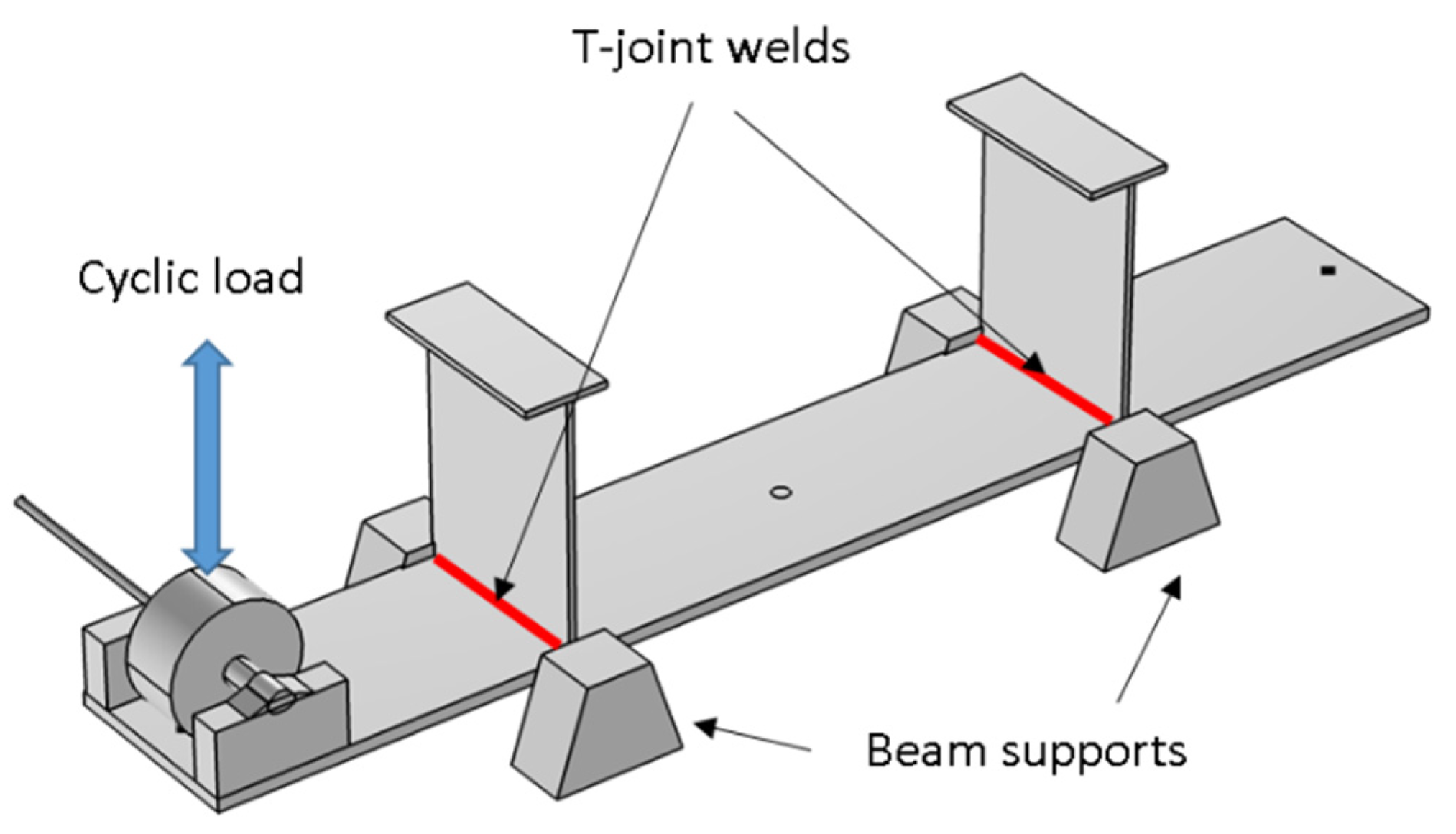
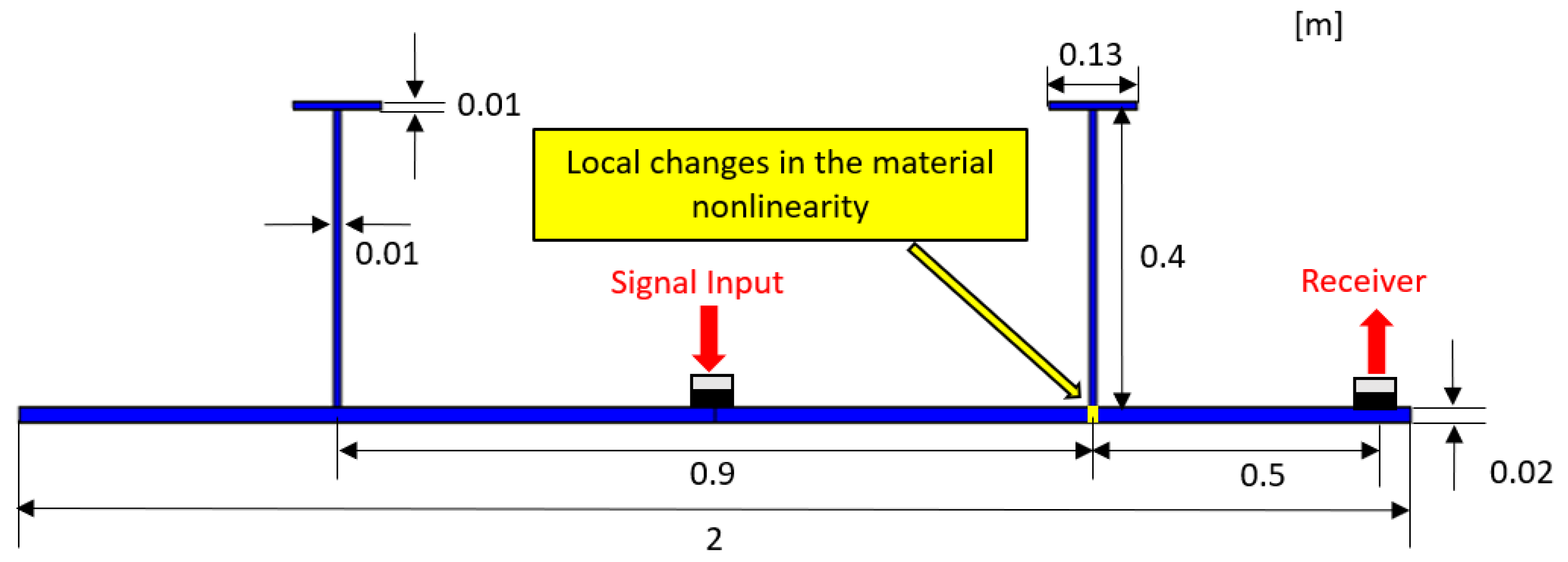

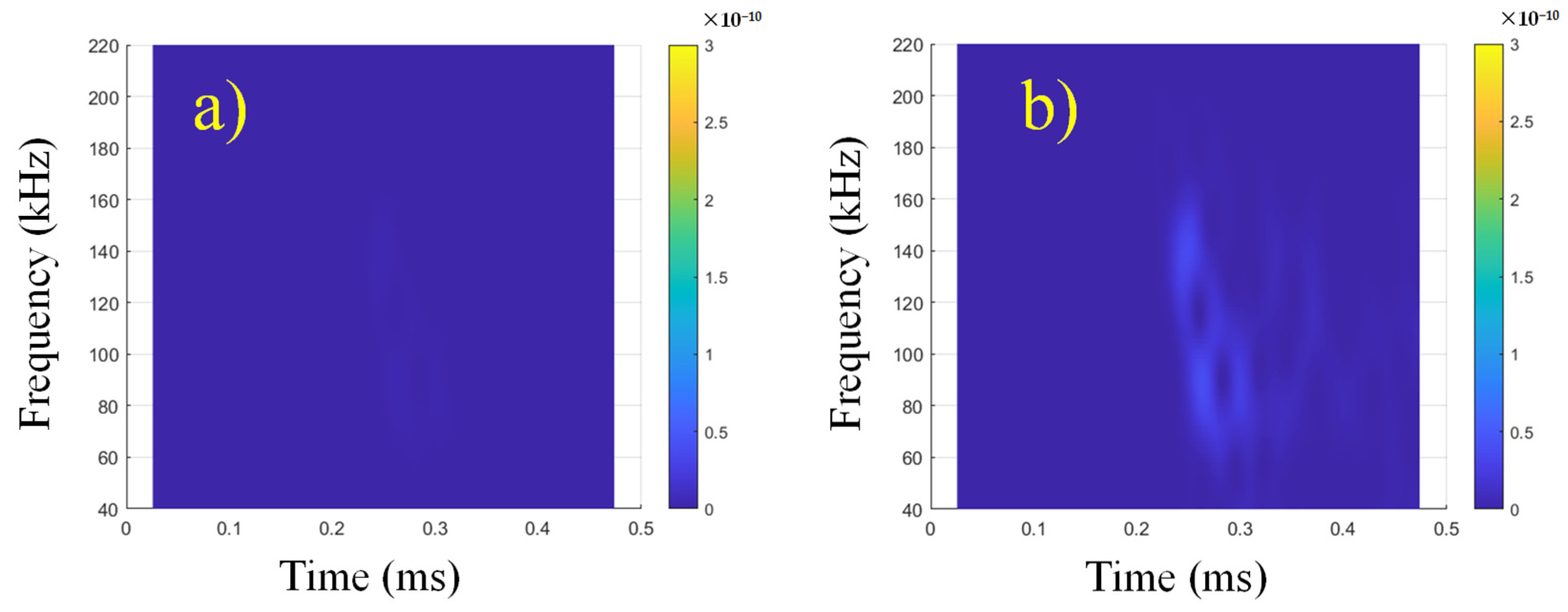
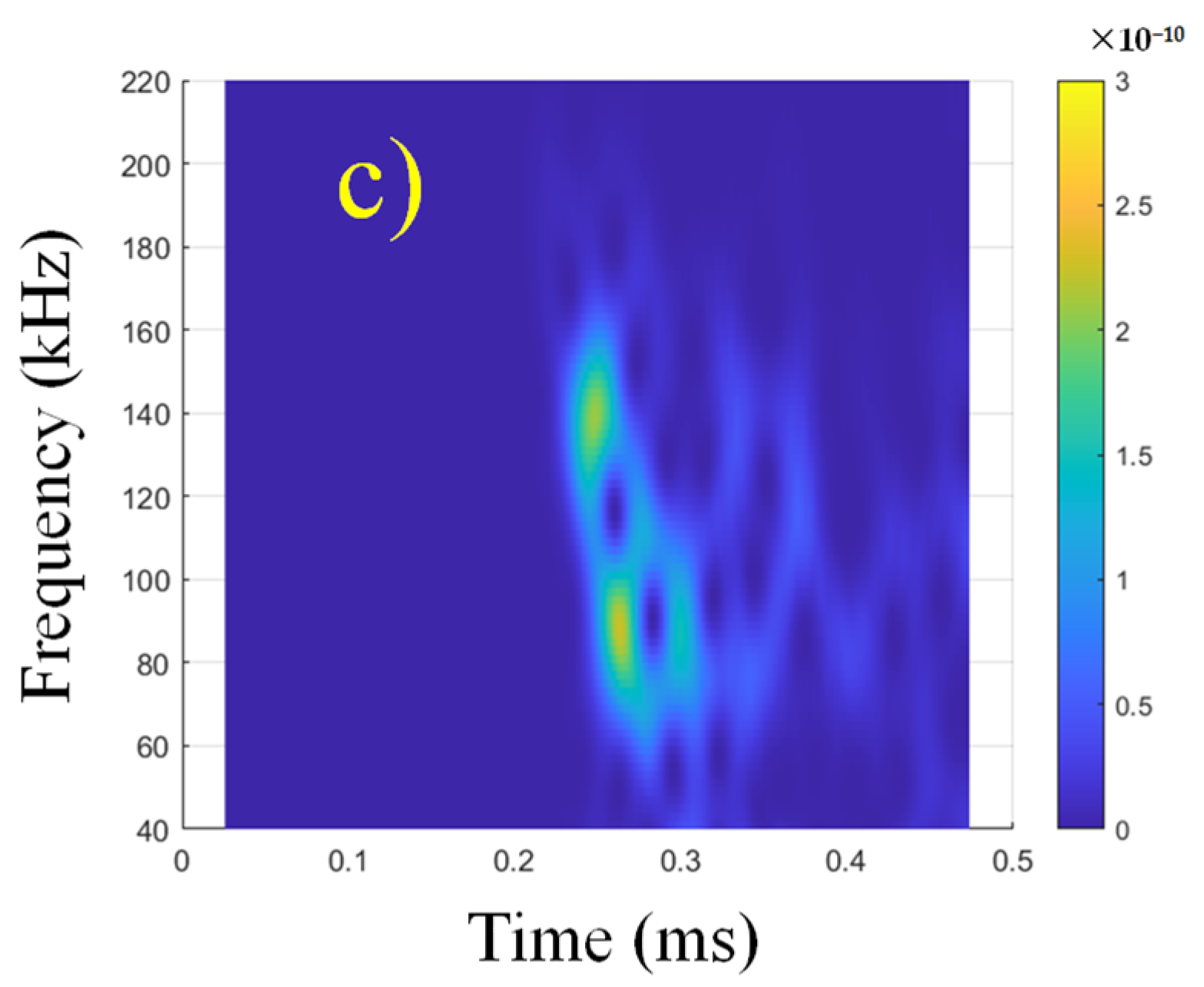


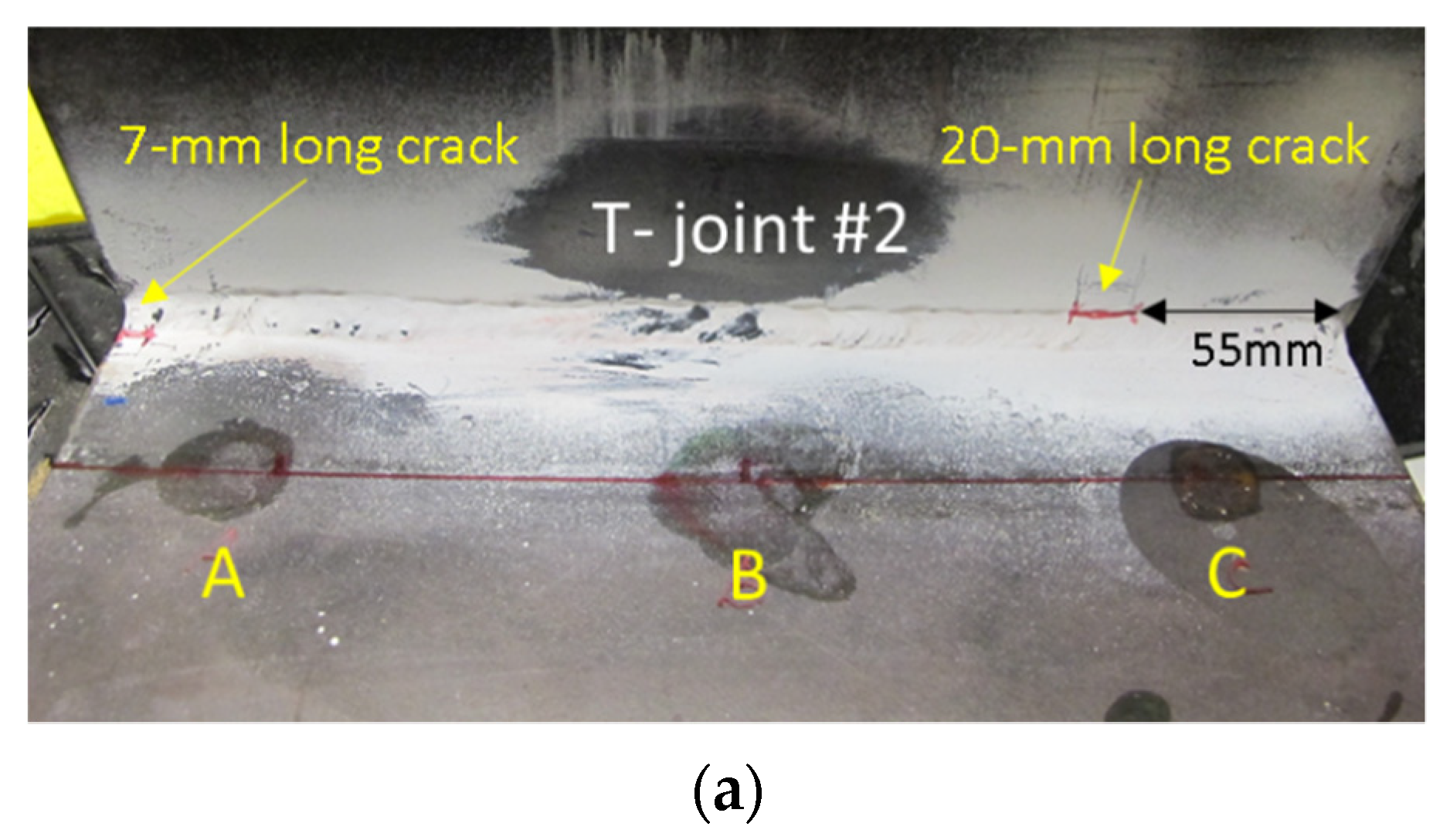
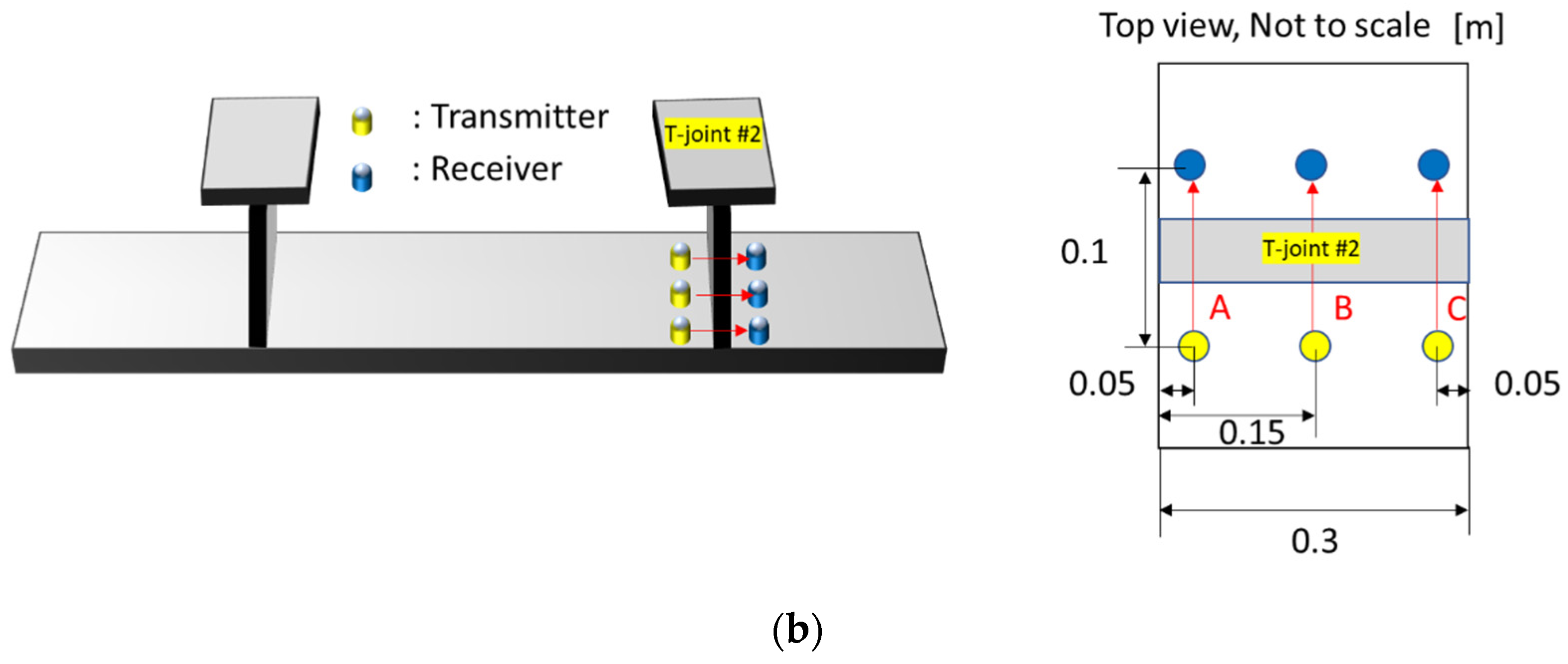

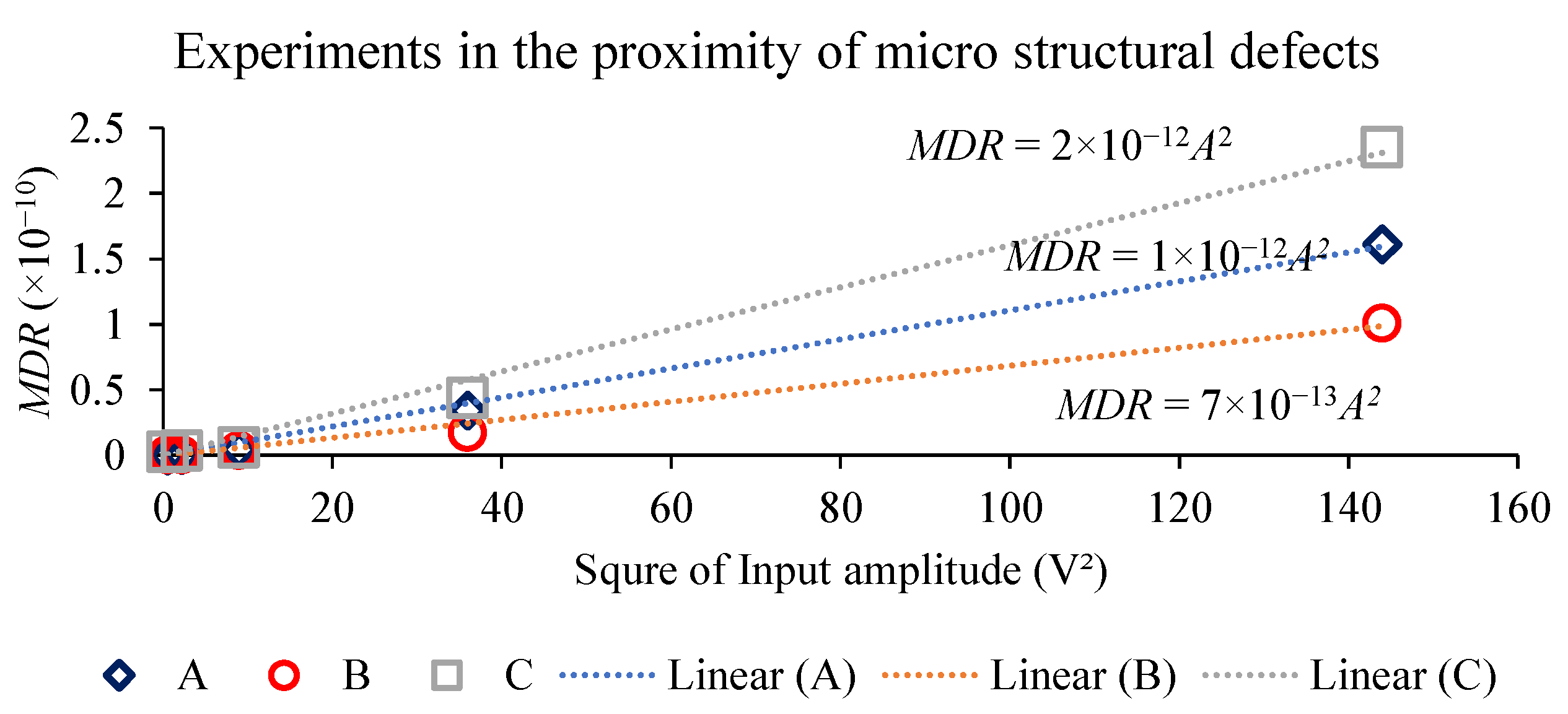
| Input | Primary Wave | Second Harmonic Wave |
|---|---|---|
| A | UL | UNL |
| -A | -UL | UNL |
| Material | Density (kg/m3) | Young’s Modulus (GPa) | Poisson’s Ratio |
|---|---|---|---|
| AISI 4030 | 7850 | 205 | 0.28 |
| Local Material Nonlinearity | M | L |
|---|---|---|
| 0 | 0 | |
| −300 | −300 | |
| −600 | −600 |
Publisher’s Note: MDPI stays neutral with regard to jurisdictional claims in published maps and institutional affiliations. |
© 2022 by the authors. Licensee MDPI, Basel, Switzerland. This article is an open access article distributed under the terms and conditions of the Creative Commons Attribution (CC BY) license (https://creativecommons.org/licenses/by/4.0/).
Share and Cite
Ju, T.; Findikoglu, A.T. Large Area Detection of Microstructural Defects with Multi-Mode Ultrasonic Signals. Appl. Sci. 2022, 12, 2082. https://doi.org/10.3390/app12042082
Ju T, Findikoglu AT. Large Area Detection of Microstructural Defects with Multi-Mode Ultrasonic Signals. Applied Sciences. 2022; 12(4):2082. https://doi.org/10.3390/app12042082
Chicago/Turabian StyleJu, Taeho, and Alp T. Findikoglu. 2022. "Large Area Detection of Microstructural Defects with Multi-Mode Ultrasonic Signals" Applied Sciences 12, no. 4: 2082. https://doi.org/10.3390/app12042082





